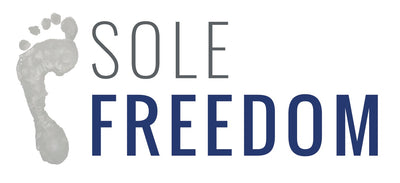Before we go any further, pause and ask yourself:
Why are shoes so expensive — and why do cheap ones still end up costing so much?
If you've ever felt sticker shock when looking at natural footwear, you're not alone. But the truth is, price and cost are not the same thing.
Today’s microdose explores:
- Why natural shoes have a higher price tag
- Why footwear costs more in Canada
- The hidden costs of unnatural shoes — to your health, your wallet, and the
Why Are Natural Shoes More Expensive?
Let’s get one thing straight:
The most expensive shoes are the ones that damage your feet.
That $150 pair of mainstream “supportive” running shoes might seem like a deal — until you add the cost of plantar fasciitis, posture issues, joint pain, and long-term muscle dysfunction. Add up the physio visits, podiatry appointments, and possibly surgery, and you’ve got a very expensive pair of shoes.
Natural footwear flips the script with a design philosophy that prioritizes foot health:
- Less material → fewer barriers to movement
- Better materials → more durability, less environmental impact
- Minimalist design → promotes natural strength, mobility & balance
Natural shoe companies like Shamma, Origo, and Lems don’t mass-produce in mega factories. They often:
- Manufacture in small batches
- Use ethically sourced materials
- Pay workers fair wages
- Avoid flashy “tech” gimmicks that reduce shoe lifespan
Yes, this makes them more expensive upfront. But they’re cheaper over the long run — and far better for your feet, body, and conscience.
🇨🇦 Why Is Footwear More Expensive in Canada?
At Sole Freedom, we often get asked why our Canadian prices are higher than those in the U.S. or Europe. The answer? It’s not the brands — it’s the system.
Here’s why:
1. Outdated Footwear Tariffs
Canada imposes an 18% tariff on imported shoes — even though we barely manufacture footwear domestically. That’s not protectionism. That’s just taxation. On top of that:
- Brokerage fees from UPS or FedEx tack on another 5–10%
- Then add 13% HST and any provincial tax
- You even get taxed on the tariff itself
Real invoice example (Quebec):
- Cost of shoes: $173.74 CAD
- Tariff: $31.27
- Brokerage fee: $17.00
- Taxes & Fees: $33.25
- Total extras: $81.52 (47% of the shoe cost!)
When you buy natural footwear through us, we pay these on the wholesale level — so you don’t get slammed with charges on your doorstep.
2. Currency Manipulation & Inflation
Our footwear is priced in USD, but due to poor currency management and inflation driven by government overspending, Canadians now pay much more.
In 2021, a $100 USD shoe cost us about $120 CAD.
In 2025, that same shoe costs us $138 CAD — a 15% increase in just two years.
That’s not brand greed — that’s currency devaluation, and it’s shrinking your buying power.
The Hidden Costs of Unnatural Shoes
Unnatural footwear — stiff, narrow, cushioned, elevated — doesn’t just distort your foot. It sabotages your entire kinetic chain.
Here’s what cheap shoes might actually cost you:
- Plantar fasciitis
- Bunions & hammertoes
- Stiff, achy feet
- Poor posture
- Knee, hip, and low back pain
- Chronic compensation injuries
They’re not cheap if they make you weaker with every step.
On the flip side, natural shoes restore function, not restrict it. Every walk becomes rehab. Every step rebuilds strength.
Natural Footwear: A Better Investment for the Planet Too
Let’s not forget the environmental cost of cheap shoes:
- More plastic, glue, and synthetic junk
- More shipping waste
- Shorter lifespan = more landfill contribution
Natural shoes follow a “less but better” philosophy. Fewer materials. Smarter design. Longer lifespan. Lower carbon footprint.
What You’re Really Paying For
- Natural shoes = higher price, but better design, ethical sourcing, healthier movement, and long-term savings
- Unnatural shoes = lower price, but long-term damage to your feet, posture, wallet, and the planet
- Footwear in Canada = inflated by tariffs, brokerage fees, and currency mismanagement
- The truth? A higher sticker price doesn’t always mean a higher cost.
If you’re investing in your foot health, mobility, and longevity — natural shoes might be the cheapest choice of all
ciao for now,
Nick
FAQ: Natural vs. Unnatural Shoes & Canadian Pricing
1. Why do natural shoes cost more than regular shoes?
Natural shoes use higher-quality materials, ethical labor, and minimalist designs that support foot function — unlike cheap shoes built for mass production and profit.
2. Why are shoes more expensive in Canada?
Canada adds an 18% tariff on imported shoes, plus brokerage fees and taxes. Currency inflation also reduces Canadian buying power against the U.S. dollar.
3. Are cheap shoes really that bad for your feet?
Yes. Stiff, narrow, and over-cushioned shoes limit foot function, which leads to joint pain, poor balance, and long-term dysfunction. They often cost more in the long run.
4. Are natural shoes worth it?
Absolutely. Every step becomes a micro-treatment for your feet. Natural shoes help restore strength, mobility, and posture with less need for costly interventions later.


Comment (1)
Much appreciation for your work and company! The price and tariff breakdown are truly insightful and it’s quite eye-opening how the current policies are setting our price predicament at. I don’t specifically recall the gouverment using that tariff money to bolster our local industries either, at least not when it comes to any type of shoe-making/textile. It’s a wide net being cast, yet it’s not feeding scores of villages I would say.